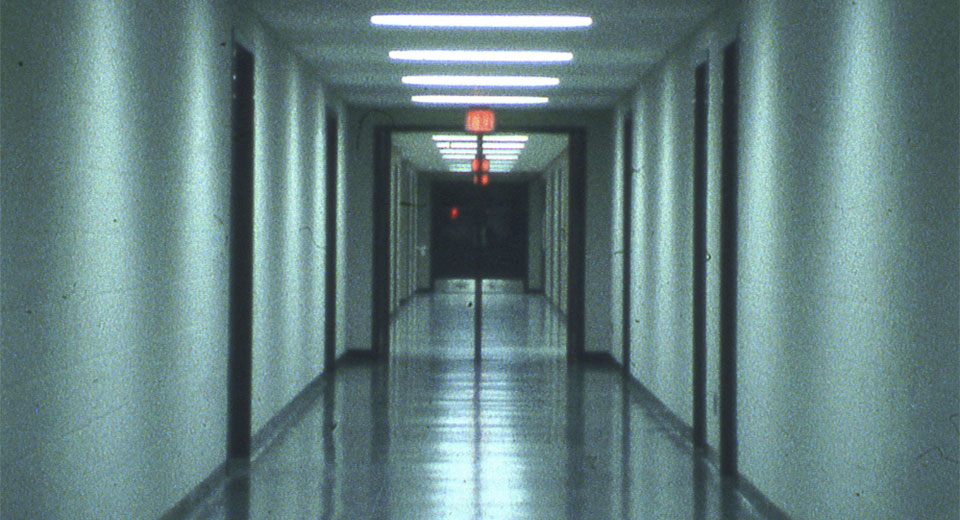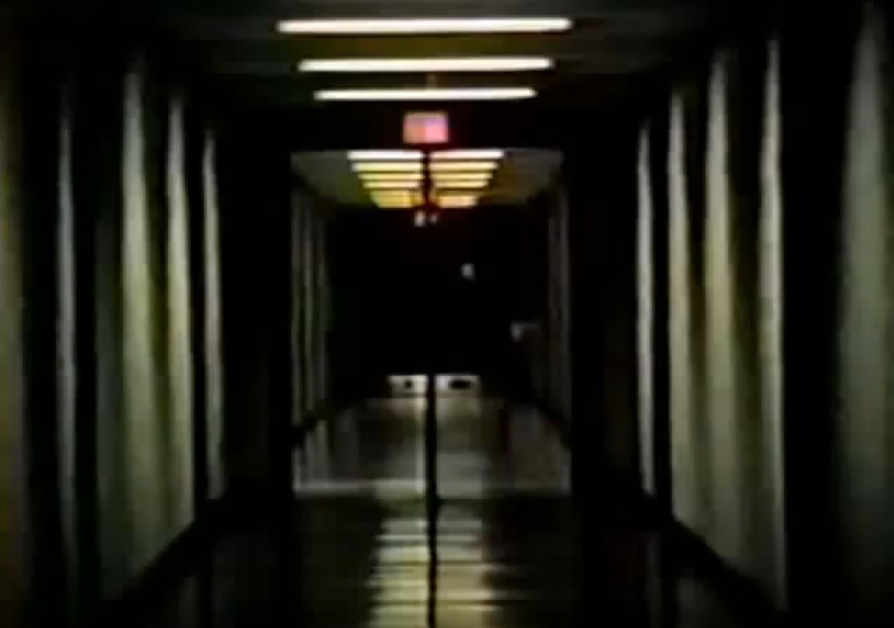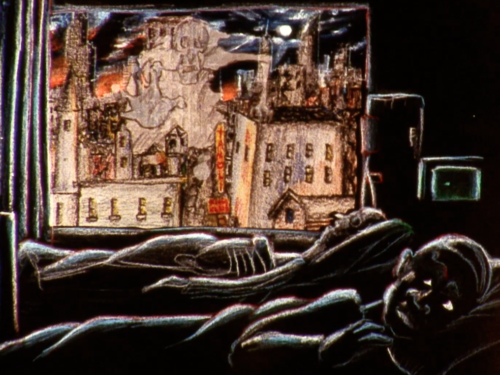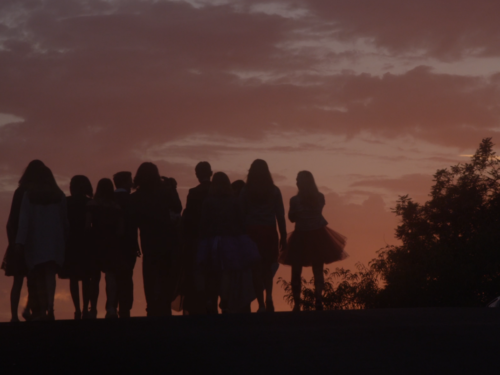Serene Velocity finds the magical and the monstrous in an everyday location and the fundamental materials of filmmaking. Bennett Glace argues Gehr’s film isn’t just one of the great experimental or structural films — it’s one of the great horror films.
Ernie Gehr’s seminal Serene Velocity (1970) is an experimental film in the truest sense. First, Gehr happened upon the right hallway during his brief stint as a summer lecturer at the State University of New York’s Binghamton campus. Unremarkable to any other passerby, it provided the ideal setting for “maximi[zing] the tension between representation and abstraction, as well as the potentials [he] began to sense regarding the intervals between frames.” Serene Velocity is also one of the essential structural films. Gehr next marked a piece of tape, “every five millimeters or so” to guide recalibration of his lens and recorded some test footage to determine the best pace and projection speed for the film. Settling on a structure of alternating four-frame sequences and silent projection speed, Gehr set out to make his version of the single-take film. Serene Velocity is also one of the best horror films ever made, utterly unique in its visceral effect and nightmarish imagery.
At first, Serene Velocity looks almost too reminiscent of horror at its most hacky. Any viewer can imagine the sounds of heavy breathing, a heartbeat, or Bernard Hermann’s Psycho strings over its increasingly dramatic movement. The steady zooms, inwards and outwards after four-frame pauses, create a sense of motion that is appropriately assaultive and easily likened to thrusting, lunging, punching, or stabbing.1 Within seconds, it’s clear that Serene Velocity will most call to mind another Hitchcock classic, Vertigo. 2 Gehr’s lens’ movements pull and stretch the frame like the dizzying dolly zooms Hitch used to evoke Scottie Ferguson (Jimmy Stewart)’s paralyzing fear of heights. While those momentary hallucinations dropped Ferguson into a shocked state of catatonia, there is no loss of consciousness in Gehr’s film. We are suspended in a hypnagogic, hallucinatory state, between waking and dreaming as well as between everyday seeing and abstracted, distinctly cinematic viewing. Our sense of unease grows whether or not we begin to feel like a part of us is moving in concert with the frame. Throughout Serene Velocity’s 23 minutes, Gehr not only telescopes a hallway at the State University of New York’s Binghamton campus,3 unmooring us from a comfortable fixed perspective, but also seems to stretch and contract time alongside the fixtures on the walls, floor, and ceiling. The filmmaker himself acknowledges that sitting through the film can prove a torturous ordeal for viewers who are merely waiting it out.
Despite the light that eventually shines at the end of its drab institutional tunnel, there is not, as in many other structural films, a clear end in sight throughout most of Serene Velocity’s runtime. Gehr adjusts his zoom lens so steadily as to convince you he could go on forever. If you’re watching the film for the first time, or the first time in a while, you can’t know for certain how close Gehr will bring you to the door before Serene Velocity finally ends. Beyond the runtime, there is little to help an overwhelmed viewer find their bearings and enjoy a sense of progress. Though the film’s sense of motion is consistent and eventually predictable, we can’t say for sure whether we’re moving or if the floor, ceiling, and walls are moving, or perhaps even changing shape, around us. We know, however, that whichever direction we’re headed, wherever the momentum is coming from, we never make quite enough progress. Whether the door portends salvation or doom, it remains tauntingly out of our grasp. What’s more, in calling to mind an effect most associated with heights and a stomach-dropping sense of dread, Gehr manages to subvert conventional notions of up and down while subverting our ideas of what a horror film, a film of any kind, is supposed to look and feel like.

Early on in a 1990 overview of Gehr’s work for Film Quarterly, Scott MacDonald splits the history of cinematic photography into two distinct modes and identifies a blending of the two as one of the central accomplishments of Gehr’s practice. Beginning in 1968, with Wait, MacDonald writes, Gehr manages to “hover dramatically” between the different cinematic approaches introduced by the Lumière brothers (“record[ing] the visual scene”) and by Georges Méliès (“magically transform[ing] reality”). Serene Velocity, which MacDonald would go on to call a kind of thesis statement for Gehr’s body of work, not only blends and complicates these approaches, but intensifies Gehr’s movements between the two. “Hover dramatically” is an understatement for the ways Serene Velocity throws the viewer across its hallway and the way it transforms both its benign setting and materials.
Gehr’s queasy composition bears much the same hypnotizing, dehumanizing sense of municipal surreality as some of George Tooker’s most famous paintings. It’s not hard to imagine columns of dead-eyed students and academics trudging through its endless, fluorescent-lit halls like Tooker’s subway denizens and office dwellers. In Serene Velocity, Gehr bends and reshapes a similar space in ways only a camera could make possible; Serene Velocity stages a nightmare via explicitly cinematic means, prizing the filmmaking apparatus at its most fundamental. Creating an intense emotional and sensory experience from the rudiments of film, elements of the creative process that are typically hidden from the viewer, it taps into a cinematic subconscious.
I can only speak for the visual language of my own dreamscapes, but hallways like this one, almost anonymous and decidedly discomfiting, are practically ubiquitous. In dreams they could lead anywhere and morph imperceptibly from one recognizable hallway to another or a mix of several. On a typical night, one school corridor might suddenly become another or evolve into an office passageway and back again without explanation. Dreams, for all their flights of fancy, still basically rely on traditional cinematic language. However fractured, they present a version of reality and a version of a straight-ahead narrative. As soon as I realize I’m dreaming, mine tend to start moving like shitty horror movies, lurching inexplicably through their final acts as if an unseen director is suddenly scrambling to finish with a reduced budget and timeline. There is, frequently, in anticipation of waking, a sense of finality, often in spite of the events taking place. Sometimes anxiety arises from the incongruity between the sense of falling action and the lack of recognizable narrative markers. I can tell I’m about to open my eyes, but there’s no way things can come to a suitable resolution. It’s not a TV show, there’s no ‘To Be Continued’ to extend 22 minutes into 44 or more. The only possible endings look bleak; in-dream death or incapacitation often becomes inevitable. In all likelihood, I’ll rise with a start.
If we have films to thank for the visual language and narrative thrust of dreams, then we also have them to blame for some of the ways benign objects, locations, and interactions can sometimes seem uncanny or unsettling. Empty hallways and other so-called liminal spaces owe much of their unique portent to literature and, especially, film. Writers and filmmakers have convinced us that someone or something is likely lurking behind that door just as much as stories and suspicions pulled from real life. In a more typical film, a sustained shot of a hallway like Serene Velocity’s could serve just a few purposes. A filmmaker would only linger on such an image as a means of foreshadowing an arrival, communicating vague menace, or placing us within an uneasy mind. If we’re just waiting on students to fill a hallway between classes or a solitary faculty member to leave one room for another, no director would spend more than a beat on an establishing shot of an empty hall without meaning to. Even if hallways like the one featured in Serene Velocity are a personal nocturnal auteurist obsession, even if other dreamers don’t encounter them all the time, filmmakers certainly recognize their potential for both vague and explicit menace. To employ a recent example, Greta Gerwig and cinematographer Rodrigo Prieto use a dolly zoom, a more direct Vertigo homage, to suggest the endless monotony of Mattel’s halls as well as the ineffable horror the real world holds for Barbie (Margot Robbie). Here, as in countless previous examples, the camera focuses on a hallway and a distant door as a way of suggesting what could (and, likely, will) come toward the viewer at any moment. The long steadicam tour through the Overlook Hotel in Stanley Kubrick’s The Shining (1980) is perhaps the most obvious example of a filmmaker exploiting the dread inherent in a long, empty hallway.
Gehr’s film compares favorably and proves more genuinely frightening than these Hollywood efforts as well as Standish Lawder’s more outwardly horror-inflected avant garde short, Corridor (1970). Like Gehr, Lawder depicts a lengthy, otherwise unremarkable hallway. Unlike Gehr, Lawder adds an eerie soundtrack and peoples the film with mysterious figures. Despite pulling from a far deeper bag of filmmaking tricks, he winds up with the shallower of the two films. Whereas Gehr takes the spooky hallway to its apotheosis, Lawder settles for taking it to its exceedingly obvious extreme.
In both his assessment for Film Quarterly and his conversations with Gehr, published in A Critical Cinema 5,4 MacDonald describes a range of ways to watch and experience Serene Velocity. He echoes his take on Gehr’s minimalist History when he likens the geometric designs visible in Serene Velocity’s subverted everyday mise en scene to a mandala. When the viewer, MacDonald writes, begins to absorb the film as a series of paired images rather than a potentially violent zoom through three-dimensional space, the effect can shift from maddening to meditative. Employing a less lofty analogy, he likens the image-to-image transition throughout Serene Velocity to a blinking neon sign. Even when affecting less-focused vision, merely soaking in its imagery, Gehr’s film offers different kinds of potentially revelatory abstraction. Viewed as a prismatic, three-dimensional plane, it plays like a deconstructed “stargate sequence” from 2001: A Space Odyssey (1968). Adopting the more meditative lens, viewers observe pairs of colorful smears and contemplate their subtle differences. Like a sky filled with clouds or a series of ink blots, the film encourages its audience to let their own wandering minds guide them in identifying shapes and patterns. The tension between the various styles of viewing and their contrasting effects upon the viewer is itself disorienting and fitting the cinematic dreamscape Serene Velocity enables. In dreams — and in horror films that aim for so-called dreamlike logic — familiar locations and people may seem ineffably ‘off’ or take on more inscrutable, even sinister, forms. Horror may come from the world’s refusal to obey traditional laws of physics or an inability to square these diversions with our everyday experience.
Gehr calls shooting Serene Velocity a “nightmare” and the memories he relates to MacDonald sound appropriately like a tortured dream or a sleepless night without end. Hoping to finish most of his work within a matter of hours, Gehr instead spent all night making his masterpiece by hand. By the final few reels, those hands were painfully swollen and Gehr struggled to make the necessary lens adjustments. It was only by dint of sheer determination and luck that Gehr managed to capture morning sunlight near the end of his ordeal. Gehr acknowledges a number of mistakes and an altogether unscientific approach to measuring the distance between frames. These imperfections, only visible to the most attentive of repeat viewers, suggest the sometimes subtle ways dreams reveal themselves as unreal. The circumstances of Serene Velocity’s production, with Gehr running his head under the sink to awaken his senses, suit the hypnagogic state it evokes. Watching it can feel like dozing off and suddenly finding oneself just seconds or minutes in the future.
As it reaches its close, Serene Velocity’s inward and outward movements are so aggressive as to suggest a massive beating heart behind its double doors. Call it the heart of this institution, a place where truly visionary filmmaking briefly flourished. At SUNY-Binghamton, Gehr and fellow filmmakers including Larry Gottheim and Ken Jacobs established, for a time, a new epicenter for bold, critical cinema that has arguably never been equalled for output5 or influence. Both textually and meta-textually, Serene Velocity’s pumping suggests the lifeblood coursing through its corridors and its sunlit final frames suggest not only daylight breaking through Binghamton’s cloudy skies but a still-shining spark of cinematic inspiration. For all the portent I find in it, I consider Serene Velocity an immensely hopeful film. Though the first-time viewer may find it alienating — it nauseated Gehr and infuriated MacDonald — it is sure to both embed itself within their memories and jolt them out of their complacency, awakening them to the possibilities of films and filmmaking. Few films offer a more compelling way of facing one’s fear of unconventional cinema.
Find the complete October Horror 2023 series here:

(Split Tooth may earn a commission from purchases made through affiliate links on our site.)
- Scott MacDonald writes that Ken Jacobs called the film “sexy” at its inaugural screening, perhaps echoing the way the hallway appears to thrust toward the viewer.
- I’d bet my life that Gehr would not make this comparison himself or even welcome it. His own Rear Window, he says, is called that in spite of the same-named Hitchcock classic.
- Visiting and full-time members of the SUNY-Binghamton faculty during the ’60s and ’70s included Gehr, Larry Gottheim (who established the school’s Cinema department), Ken Jacobs (who seems to have gotten all the credit), Peter Kubelka, Tony Conrad, and Nicholas Ray (whose We Can’t Go Home Again, the crowning achievement of an acclaimed career, was made alongside Binghamton students and finally released in full in 2013). This period’s student body has proven similarly important to cinematic history thanks to the contributions of J. Hoberman, Phil Solomon, Camille Paglia, Alan Berliner, Reneé Shafransky and numerous others. Scott MacDonald’s Binghamton Babylon (2015) tells the story of SUNY-Binghamton’s decade-long heyday in the form of an oral history with contributions from notable figures including many of these teachers and pupils.
- In the career-spanning conversation, Gehr describes the more or less hellish experience of making Serene Velocity as well as the happy accidents necessary for its unique power. Gehr’s description of the film’s “handcrafted” (as MacDonald puts it) quality is especially interesting: “Yes, and eventually [that handcrafted quality] was important to me. Like that beautiful internal ‘light’ that emanates from within the image, opalescent, and variable, without bringing up associations with the romantic or the picturesque. That radiating luminance then merges and climaxes at the end with the luminosity of the white light that slowly bleeds in from the outside declaring the arrival of ‘day’ . . . that was a wonderful gift that I had not considered and which is due to the pulsing fluorescent lights in the corridor and recording the images single frame, manually.”
- We Can’t Go Home Again (1973/2013), Gottheim’s Horizons (1973), and Jacobs’ Tom, Tom The Piper’s Son (1969) are some of the best and most notable of the film’s produced at Binghamton.




